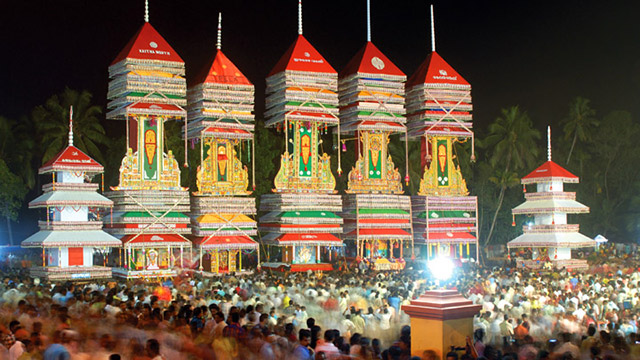The Chettikulangara Bhagavathy Temple, situated in the Alappuzha district of Kerala, India, is a revered Hindu temple dedicated to Goddess Bhagavathy. This ancient temple, with its rich history, unique rituals, and vibrant festivals, holds a special place in the hearts of devotees and is a symbol of Kerala’s cultural and religious heritage. In this article, we will explore the history, architecture, rituals, and cultural significance of the Chettikulangara Bhagavathy Temple.
Historical Background
The exact origins of the Chettikulangara Bhagavathy Temple date back many centuries and are steeped in legend and mythology. The temple is believed to have been consecrated by Lord Parashurama, an avatar of Lord Vishnu and the mythical creator of the land of Kerala. Over the centuries, the temple has undergone renovations and additions, and it stands as a magnificent testament to Kerala’s architectural and religious traditions.
Architectural Marvel
The temple’s architecture is a fine example of traditional Kerala temple architecture. Key architectural elements include:
- Gopuram: The temple entrance is adorned with a towering gopuram (tower) featuring intricate sculptures and carvings, which is characteristic of Kerala temple architecture.
- Sreekovil: The sanctum sanctorum, known as the sreekovil, houses the main deity, Goddess Bhagavathy. It is built in the traditional Kerala style with a pyramid-shaped roof and finely carved wooden panels.
- Balikkalpura: The temple complex includes a balikkalpura, an open-air pavilion where special rituals and offerings are performed during festivals.
Rituals and Festivals
- Kumbha Bharani: The annual Kumbha Bharani festival is the most significant celebration at the Chettikulangara Bhagavathy Temple. It usually falls in February or March and is marked by vibrant processions, traditional music, and dance performances. The highlight of the festival is the Kettukazhcha, a grand procession of elaborately decorated chariots and effigies.
- Thalappoli: Thalappoli is another important ritual at the temple where women and young girls carry lighted lamps and flowers in a procession to honor the goddess.
- Makam Thozhal: The Makam Thozhal is a monthly ritual observed on the Makam star day of the Malayalam calendar. Devotees gather to seek the blessings of Goddess Bhagavathy during this auspicious occasion.
Cultural Significance
The Chettikulangara Bhagavathy Temple is not only a place of worship but also a center for the preservation and promotion of Kerala’s traditional art forms, including Kathakali, Ottamthullal, and classical music. These cultural performances are often held at the temple during festivals and special occasions.
Visiting Tips
- Visitors should dress modestly when visiting religious sites in India, covering shoulders and knees.
- Respect the temple’s customs and traditions, and adhere to any dress codes that may be in place.
How to Reach
- By Air: The nearest airport is Trivandrum International Airport, approximately 95 kilometers (59 miles) away.
- By Rail: The nearest railway station is Mavelikara Railway Station, located about 5 kilometers (3.1 miles) from the temple.
- By Road: Chettikulangara is well-connected by road and can be reached by taxi or private transport from nearby towns like Alappuzha and Mavelikara.
Conclusion
The Chettikulangara Bhagavathy Temple stands as a sacred abode of Goddess Bhagavathy, a symbol of divine grace and cultural richness in Kerala. Its architectural beauty, vibrant festivals, and cultural significance make it a must-visit for those seeking to immerse themselves in the spiritual and cultural heritage of this enchanting region. A visit to this temple is not just a journey of devotion but also an opportunity to witness the traditions and rituals that have shaped Kerala’s identity over the centuries.
Chettikulangara Bhagavathy Temple
Chettikulangara Bhagavathy Temple: A Divine Abode in Kerala
The Chettikulangara Bhagavathy Temple, situated in the Alappuzha district of Kerala, India, is a revered Hindu temple dedicated to Goddess Bhagavathy. This ancient temple, with its rich history, unique rituals, and vibrant festivals, holds a special place in the hearts of devotees and is a symbol of Kerala’s cultural and religious heritage. In this article, we will explore the history, architecture, rituals, and cultural significance of the Chettikulangara Bhagavathy Temple.
Historical Background
The exact origins of the Chettikulangara Bhagavathy Temple date back many centuries and are steeped in legend and mythology. The temple is believed to have been consecrated by Lord Parashurama, an avatar of Lord Vishnu and the mythical creator of the land of Kerala. Over the centuries, the temple has undergone renovations and additions, and it stands as a magnificent testament to Kerala’s architectural and religious traditions.
Architectural Marvel
The temple’s architecture is a fine example of traditional Kerala temple architecture. Key architectural elements include:
- Gopuram: The temple entrance is adorned with a towering gopuram (tower) featuring intricate sculptures and carvings, which is characteristic of Kerala temple architecture.
- Sreekovil: The sanctum sanctorum, known as the sreekovil, houses the main deity, Goddess Bhagavathy. It is built in the traditional Kerala style with a pyramid-shaped roof and finely carved wooden panels.
- Balikkalpura: The temple complex includes a balikkalpura, an open-air pavilion where special rituals and offerings are performed during festivals.
Rituals and Festivals
- Kumbha Bharani: The annual Kumbha Bharani festival is the most significant celebration at the Chettikulangara Bhagavathy Temple. It usually falls in February or March and is marked by vibrant processions, traditional music, and dance performances. The highlight of the festival is the Kettukazhcha, a grand procession of elaborately decorated chariots and effigies.
- Thalappoli: Thalappoli is another important ritual at the temple where women and young girls carry lighted lamps and flowers in a procession to honor the goddess.
- Makam Thozhal: The Makam Thozhal is a monthly ritual observed on the Makam star day of the Malayalam calendar. Devotees gather to seek the blessings of Goddess Bhagavathy during this auspicious occasion.
Cultural Significance
The Chettikulangara Bhagavathy Temple is not only a place of worship but also a center for the preservation and promotion of Kerala’s traditional art forms, including Kathakali, Ottamthullal, and classical music. These cultural performances are often held at the temple during festivals and special occasions.
Visiting Tips
- Visitors should dress modestly when visiting religious sites in India, covering shoulders and knees.
- Respect the temple’s customs and traditions, and adhere to any dress codes that may be in place.
How to Reach
- By Air: The nearest airport is Trivandrum International Airport, approximately 95 kilometers (59 miles) away.
- By Rail: The nearest railway station is Mavelikara Railway Station, located about 5 kilometers (3.1 miles) from the temple.
- By Road: Chettikulangara is well-connected by road and can be reached by taxi or private transport from nearby towns like Alappuzha and Mavelikara.
Conclusion
The Chettikulangara Bhagavathy Temple stands as a sacred abode of Goddess Bhagavathy, a symbol of divine grace and cultural richness in Kerala. Its architectural beauty, vibrant festivals, and cultural significance make it a must-visit for those seeking to immerse themselves in the spiritual and cultural heritage of this enchanting region. A visit to this temple is not just a journey of devotion but also an opportunity to witness the traditions and rituals that have shaped Kerala’s identity over the centuries.

